By David Lewis
Yesterday, in Part 1, we looked at the basics of how suppressors work and what they do when you shoot with one. But lots of people want to know…
Are Silencers Legal?
Silencers aren’t the easiest firearm accessories to purchase. They are heavily regulated, just like actual machine guns, under the National Firearms Act (NFA) of 1934, which falls under the purview of the Bureau of Alcohol, Tobacco, Firearms and Explosives (ATF).
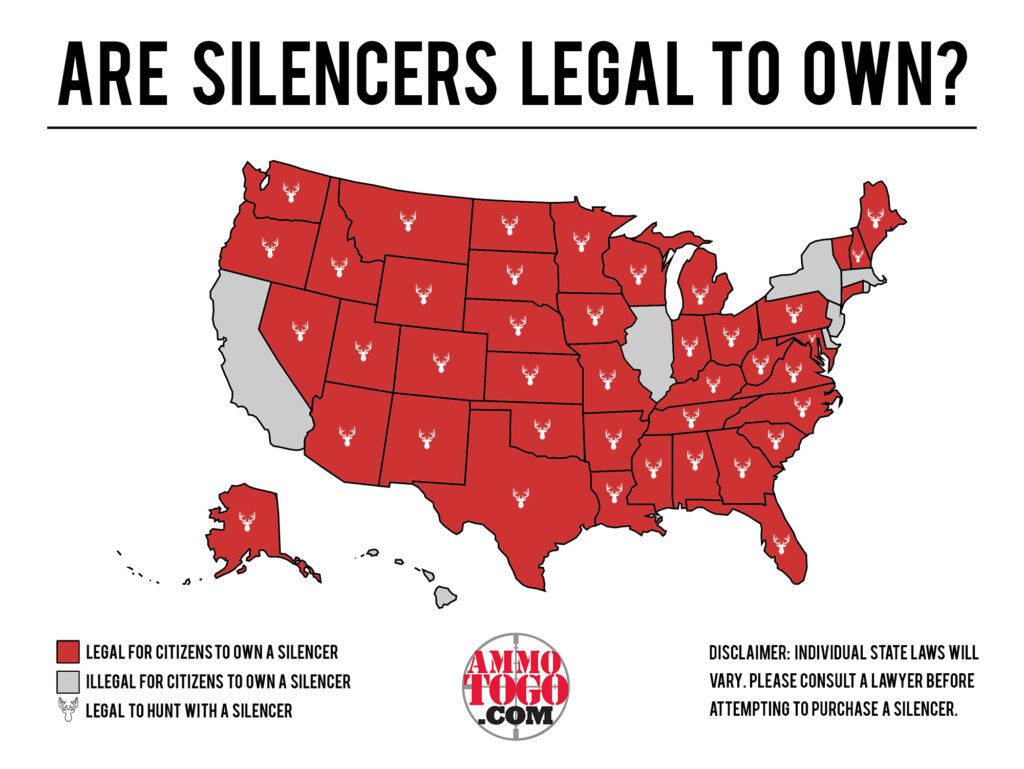
To legally purchase or possess a silencer you must meet the following criteria:
- Be a resident of the United States.
- Reside in one of the 42 states that allows civilian ownership of silencers.
- Be legally eligible to purchase a firearm.
- Be at least 21 years of age to purchase a silencer from a licensed silencer dealer.
- Be at least 18 years of age to purchase a silencer from an individual on a Form 4 to Form 4 transfer (contingent on state laws).
- Be at least 18 years of age to possess a silencer as a beneficiary of a trust or as a member of a corporation (contingent on state laws).
- Pass a BATFE criminal background check with a typical wait time of up to 10 months.
- Pay a one time $200 Transfer Tax Stamp fee.
At the time of this writing, the following 42 states allow citizens to own a silencer for personal use: AL, AK, AZ, AR, CO, CT, FL, GA, ID, IN, IA, KS, KY, LA, ME, MD, MI, MN, MS, MO, MT, NE, NV, NH, NM, NC, ND, OH, OK, OR, PA, SC, SD, TN, TX, UT, VT, VA, WA, WV, WI, WY.
Although legal to own there, hunting with silencers is currently illegal in: CT, VT. The hesitation of hunting with silencers in these states allegedly comes from trying to stop poachers from “quietly” killing game animals back in the mid 1900’s. It also seems the those state governments, like many others in the Northeast area, are simply against furthering firearm-related legislation.
Mainstream Popularity
Silencers can be somewhat cost prohibitive for most citizens. Depending on the setup, the cost of purchasing a silencer can range from a few hundred to upwards of thousands of dollars. Couple that cost with the $200 non-refundable tax and you can see why some people would like to deregulate these devices.

Despite the extensive regulations and high prices, according to the 2018 ATF Statistical Update, American citizens currently own 1,489,791 silencers, a number that has grown significantly over the past two decades. As of 2018, Texas is the leading state in silencer ownership, with just over a quarter of a million registered devices.
The surge in popularity of these devices has come from modern companies entering the marketplace with enticing advertising. There has also been an increase in education and awareness of hearing loss caused by firearms.
There are always efforts by anti-gun groups and politicians to try regulate these devices even further. Some groups have even called for a complete and total ban of silencers for firearms. The arguments in favor of bans and confiscations range from how silencers make a firearm “more deadly” all the way to “only murderers use them.”
But, if they’re so horrible and deadly, why isn’t there a thriving black market for silencers and a plethora of crimes involving them?
According to research by Paul A. Clark, from 1995-2005 there were only 153 federal convictions in which a silencer was used during the commission of a crime. Clark also wrote,
“The data indicates that use of silenced firearms in crime is a rare occurrence, and is a minor problem. Moreover, the legislative history of silencer statutes indicates that these provisions were adopted with little or no debate.”
To fight back against such ridiculous and unsubstantiated claims in recent years, legislation and research have been introduced to try to deregulate the sale of silencers all together.
The Hearing Protection Act of 2017, Sportsmen’s Heritage and Recreational Enhancement (SHARE) Act, and SHUSH Act, although unsuccessful so far, have sought to amend current law to deregulate and treat silencers like other firearm accessories.
Silencer Decibel Level Testing
As far as sound measurements are concerned, we can cite decibel (dB) levels all day, but unless we have something to compare them to, the numbers are somewhat useless. With this in mind, we set out to do our own independent sound level testing.
We wanted to approach our project as scientifically and accurately as possible, without first having to get a degree in acoustics.
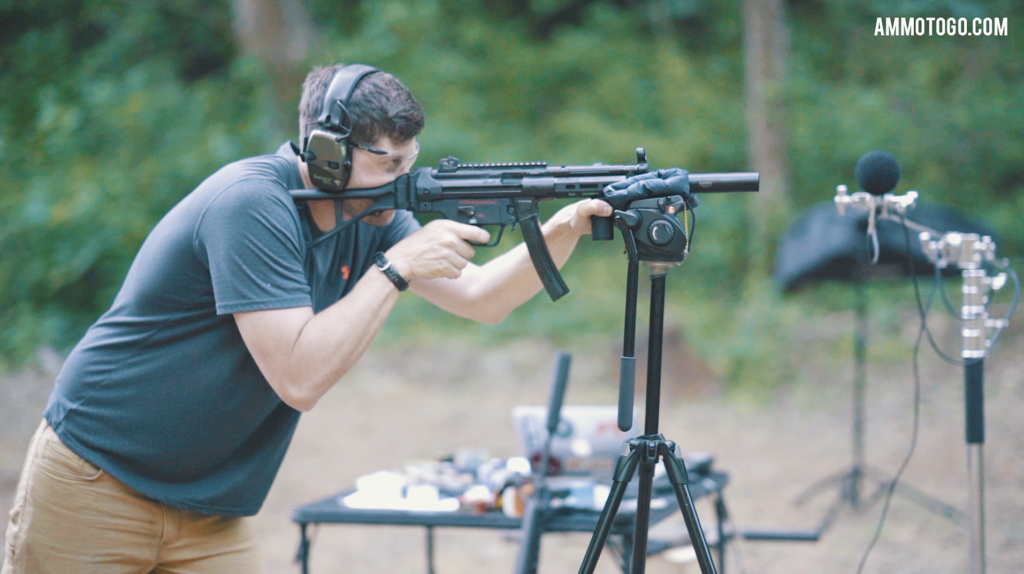
For our testing purposes, we used a Larson Davis Model LxT1-QPR Sound Level Meter.
We recorded both suppressed and non-suppressed readings, using the z-weighting method of measuring high pressure levels. This method of measurement is also referred to as linear or un-weighted.
Un-weighted is a more accurate method of evaluating potential hearing damage and is the best method to use when testing firearms. MIL-STD 1474D is considered the military standard for measuring sound. Following these standards, we placed the microphone 1 meter to the left of the muzzle and 1.6 meters above the ground, with the microphone pointing upward, at a 90 degree angle to the bore. All testing was completed away from any reflecting surfaces, so as to not negatively affect the audio readings.
We compared five of the most popular handgun and rifle calibers available on the market today, testing 30 different SKUs of ammunition in the process. Then, we test fired five rounds suppressed and three un-suppressed with each brand of ammo to find an average dB level.
First Round Pop
The first shot out of a suppressor at any given time will generally be louder than subsequent rounds fired. This phenomenon is commonly known as “first round pop” or FRP.
This is caused by the burning off of oxygen that has filled the silencer baffles and chambers when the action is left open or the device has not been in recent use. With FRP in mind, we wanted to gather more testing data to find an average suppressed level, compared to our test shots when firing unsuppressed.
Rifle Caliber Testing
Three of the most popular rifle calibers are .308 Winchester, .223 Rem/5.56mm, and .22LR. We chose two different barrel lengths as one of our test variables, one shorter and one longer. It’s reasonable to assume that the longer barreled firearms will have lower decibel readings.
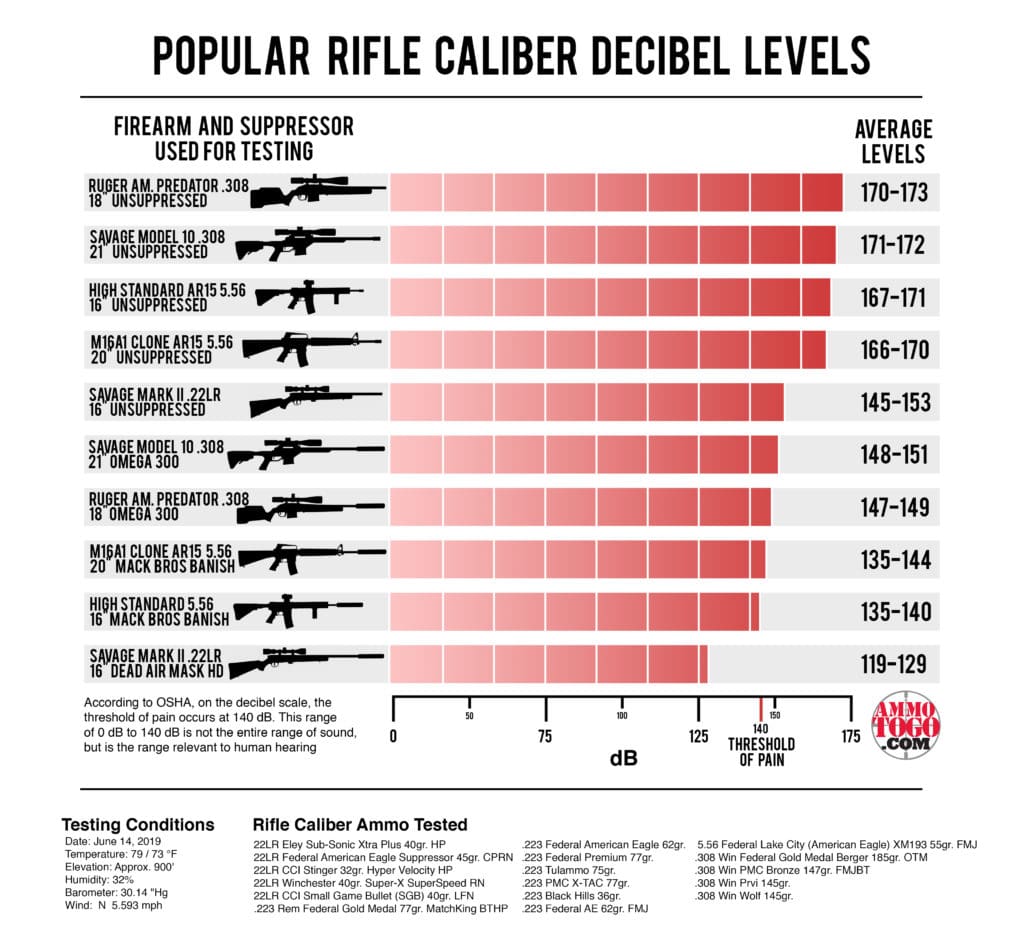
Suppressed vs. Un-suppressed .22 Long Rifle
As expected, this smaller load had some of the lowest dB readings for the rifle calibers. The lowest average suppressed measurement of 119.34 dB came from firing 22LR Federal American Eagle Rimfire Suppressor 45gr. CPRN ammo with a 16″ Savage Mk II.
Overall, we recorded an average of 119-129dB when firing all ammunition suppressed. These levels are comparable to the sounds you would experience when operating most power tools.
When shooting unsuppressed, this smaller caliber comes in at an average of 145-153dB, just slightly louder than the suppressed .308 rifles. It’s a level most people wouldn’t typically expect to experience from these tiny little rounds.
Suppressed vs. Unsuppressed .223/5.56mm
Unsuppressed, we recorded an average of 166-171 dB for the 16″ and 20″ AR-15 rifles. When shooting with a silencer, the levels come in at an average of 135-145dB. That’s an average reduction of 36dB between the un-suppressed and suppressed shots.
We observed a change of only 1-4dB between the two barrel lengths, both suppressed and unsuppressed.
Suppressed vs. Unsuppressed .308 Win.
Of all the rifle calibers tested, the loudest average unsuppressed measurement of 172.87 dB came from the 18” Ruger American Predator rifle firing .308 Win Federal Gold Medal Berger 185gr. OTM ammo. The same ammunition fired with a suppressor came in at an average of 148.4 dB.
While that’s a reduction of almost 25 dB, the sound of a suppressed .308 load will still result in hearing damage if additional ear protection is not worn.
Pistol Caliber Testing
We tested three of the most popular pistol calibers, 9mm, .45 ACP, and .22LR, with varying barrel lengths.

Suppressed vs. Unsuppressed .22 Long Rifle
Similar to the rifle testing, .22LR had some of the lower dB readings for this round of testing. The suppressed SIG P226 conversion gave us an average of 120-128 dB for all ammo tested. When fired unsuppressed, the .22LR rounds came in at an average of 155-161 dB, just under the unsuppressed H&K MP5.
With an average reduction of 41 dB, it’s easy to see why so many people enjoy shooting this caliber with a silencer.
Suppressed vs. Unsuppressed 9mm
We chose the ever-popular GLOCK 19 and H&K MP5 for this round of pistol caliber testing. When firing the GLOCK 19 suppressed, we recorded an average of 134-140 dB, while the H&K MP5 came in at an average of 133-144 dB. The unsuppressed MP5 registered an average 160-163dB, compared to the unsuppressed GLOCK 19, with an ear-splitting average of 165-167 dB.
That’s an average reduction of 34 dB when using a silencer with a 9mm firearm.
Suppressed vs. Unsuppressed .45 ACP
We saw comparable results for .45 ACP as we did with 9mm. The average un-suppressed levels, which were some of the loudest results for the pistol calibers, came in at average of 165-167 dB, while the average suppressed levels came in 21-26 dB lower, ranging from 141-146 dB.
Both firearms used for testing in this caliber had the same barrel length of 5.5″, but are built completely different. There weren’t any measurable differences in the audio levels when un-suppressed, but we did see a 2 dB difference when using a silencer.
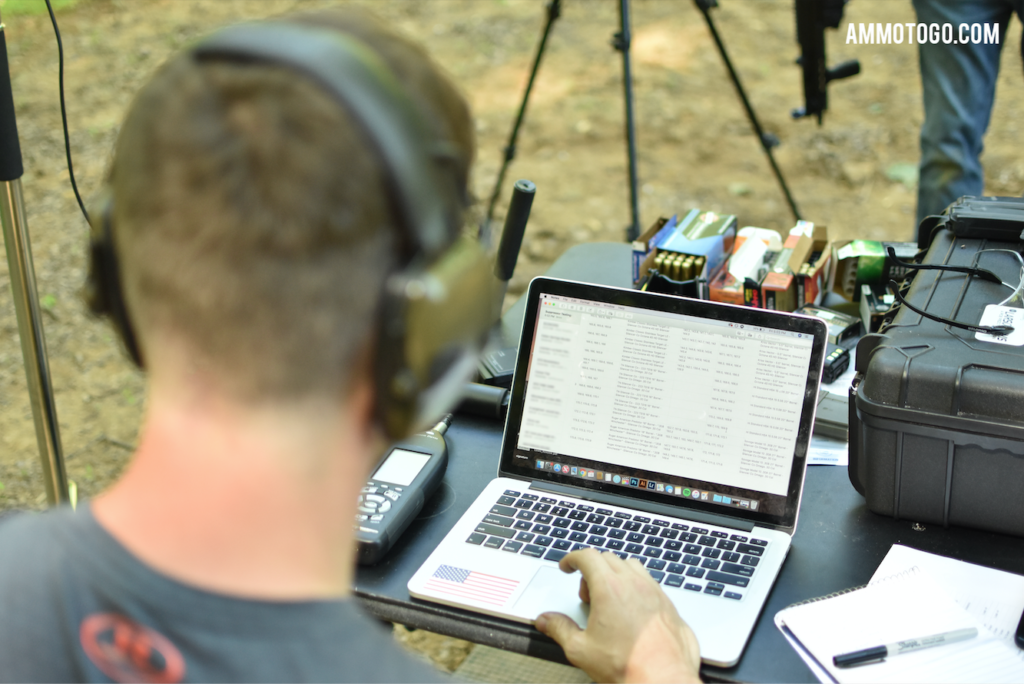
If you would like to see all of the raw test data, click the link below:
Conclusions
There are a lot of reasons for owning a silencer. Some may be about personal rights, others might just be looking for another hearing protection alternative. With a proven reduction of gunshot blasts of up to 30-40 dB, it’s hard to deny the fact that using these devices can and will protect a shooter’s hearing health.
Whatever the reason may be, educating yourself and others will help everyone better understand how these devices work, and their potential role as everyday tools, how they can influence on our hearing health, and their application in personal defense, and recreational uses.
So where do you stand on the topic? Are you one of the 1.4+ million civilians who actually own a silencer? Let us know about your experience in the comments below and if you would recommend one to someone new to the subject.
Thanks for your support, and as always, happy shooting!
Ammunition Used for Silencer Testing:
22LR
Eley Sub-Sonic Xtra Plus 40gr. HP
Federal American Eagle Suppressor 45gr. CPRN
CCI Stinger 32gr. Hyper Velocity HP
Winchester 40gr. Super-X SuperSpeed RN
CCI Small Game Bullet (SGB) 40gr. LFN
9mm
Federal BallistiClean 100gr. Frangible
.45 ACP
Remington HTP Subsonic 230gr. JHP
Winchester Ranger 230gr. JHP
Winchester Ranger 230gr. +P JHP
.223/5.56mm
Federal American Eagle 62gr. FMJ-BT
Federal Gold Medal 77gr. MatchKing BTHP
PMC X-TAC Match 77gr. Sierra MatchKing OTM
Black Hills 36gr. Remanufactured Varmint Grenade HP
Federal Lake City (American Eagle) XM193 55gr. FMJ
.308/7.62x51mm
Federal Gold Medal Berger 185gr. OTM
WPA Military Classic 145gr. FMJ
This article originally appeared at ammotogo.com and is reprinted here with permission.

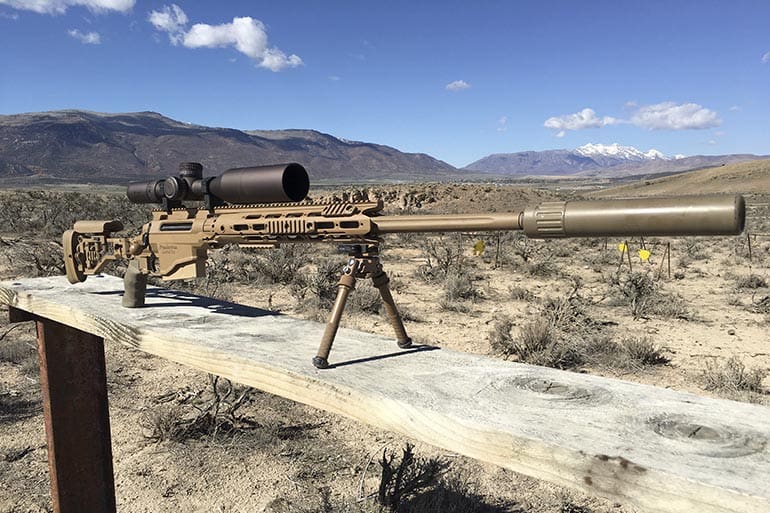



“the legislative history of silencer statutes indicates that these provisions were adopted with little or no debate.”
The NRA outright capitulated there. You can read the transcripts to see what a traitor Karl Fredrick was.
Nothing new there…
Here in NZ there is no restriction …yet. Another overlooked benefit is an up to 40% reduction in felt recoil.
Back then$200 for a tax stamp was a LOT of money for the average joe.
Back then?
It still is. Especially considering that we shouldn’t have to pay it at all.
Not in relative terms. Back then (1934) it would be equal to about $2000 or more today adjusted for inflation.
If $200 is a lot of money to you, better get out of the shooting game. And forget suppressors altogether.
I agree they should be cheap to buy and no tax stamp…like in many other developed nations. Over the counter purchase, no checks, out the door.
But it is what it is.
You understood what I meant at least. Not that the money is a large amount, it’s just an infringement and shouldn’t exist.
When a .22 can is $400 bucks (already overpriced due to the nature of what it is) that stamp is an additional 50% on top of the cost. I had to leave the asshole tax part out when I was getting the OK to buy the thing because while I’m fortunate enough that $200 wont break the bank it’s a world of a difference pitching a $400 purchase vs. a $600 one to the Mrs.
That might be true going by the “official” inflation calculators, but I think we all know how Washington DC cooks their books.
Prior to 1933, $200 was ten, $20 American Double Eagles. That works out to apx. 9.5 Troy ounces of gold, which today is worth about $13,000. That was a hell of a tax burden on a purchase that was less than half that amount. Or, after the gold was removed from the US, it was $200 in silver, which would calculate as 200X .715 OzT per dollar, for 143 OzT, which today would be worth apx. $2000. So it all depends upon the calculations one chooses to use.
But no matter what, none of the full autos then went over the $200 mark, so the tax burden was 100% of the purchase price and more. Just imagine paying 150-200 percent sales tax! Its pretty obvious that the idea was to discourage ownership rather than to create a revenue stream.
“only murderers use them.”
Yep, and that’s why 1.5 million registered silencers are linked to, well, pretty much zero murders per year.
In Libtarded states like NJ, manufacture, sales, and possession of said NFA items is illegal, yet the police and military have access to them.
Since those two professions get their manpower from the general population of “average” citizens, logic would dictate the moral and legal basis for the law is pretty much legislated and enforced by a privileged class of hypocrites.
How about Kimber in Yonkers…making guns New Yorkers can’t own…and not even NFA items…LMAO
It amazes me my companies like that would even want to stay in those States.
If you look at the demographics of the states making ownership of a silencer/suppressor illegal by the “average” citizen, simply contemplate who’s been given stewardship of the legislative bodies of government. These are corrupt sanctuary states, places of oppressive regulation, burdensome costs of living, and unsustainable deficits. Also notice these states have a net negative population growth as citizens relocate elsewhere.
And yet even most of those states have thousands of owners of suppressors. Except Hawaii and RI.
Did they get grandfathered in?
Yeah, who owns the 22,359 supressors in Illinois where, even acording this little map, suppressors are illegal for individuals to own?
Even many of the “illegal” states show thousands of civilian owners of suppressors. Grandfathered in?
Look at California, New York, Illinois. Tens of thousands.
Usually movie prop companies…
T-REX ARMS did an amazing video on this subject.
Very thorough. Very detailed.
https://youtu.be/1VWcGwPJQfc
Even illegal home-made suppressors are rarely used in crimes.
They would definitely be in the news if it was happening with any frequency.
Anyone ever do a study why this may be?
Possibly because it makes the gun about twice as long and harder to conceal? Since the VAST majority of gun crimes involve handguns.
Personally I blame Trump. BIG FAT ZERO, didn’t even try, not the smallest efforts were made on our behalf. I could understand if he’d made a legit effort and was defeated, but all he’s done is pander to us while doing ZERO on a legislative agenda. The man is a total waste of good junk food.
Meanwhile,. I’d like to own rifle and pistol suppressors. The cost keeps me from bothering, along with the record of the application in Federal hands.
He did get bump stocks banned…even Obama did not do that.
And he stated he does not like silencers. That could be the beginning.
Yes. He’s an idiot.
“I don’t like them”
What a fucken tool.
However with Clinton you would not be discussing suppressors because you wouldn’t have a gun to suppress.
there is THAT…and I bet AOC will make Hillary look like a lapdog when she becomes eligible to run
Great article. That was a lot of work to perform. Many thanks.
I think some rifles are in serious need of suppressors.
338 Lapua comes to mind.
Just a thought. I’m wondering how much reduction there is when using the wrong suppressor. Such as; I use my .30 caliber suppressor on my AR in 6.5 CM and my 5.56 AR. It’s a lot of reduction from what I hear.
I’m also looking at getting a dedicated pistol suppressor. I’m looking at a .45 caliber one that I can also use on my 9mm gats. (I already have a dedicated .22 suppressor.)
Care to tackle that project?
My understanding is you also risk baffle strikes when using a can larger than your caliber.
The risk is minimal but there.
Much better would be if there were more options for integrally suppressed items…designed and built into the weapon from the start…not just add-ons and after-thoughts.
Where did you hear that? I’ve been using suppressors for awhile and been an SOT for longer than that. “Generally” the only downsides to a too big for caliber suppressor are the added length/weight and the extra blow by of the gasses(that’s usually offset by the larger volume of the can) and is suppression. Using a 30 cal on a 6.5 or a 45 can for all your pistol needs is pretty common.
I’ve a Silencerco Hybrid I shoot on 9mm, .45, .308, .300, 5.56 and soon .35 Rem. Very happy with it. As per the manufacturer it’ll handle Lapua just fine out of a rifle length barrel. You can swap endcaps on it to give it a smaller diameter for better noise reduction on smaller calibers but I didn’t notice any difference so I just leave the large one on.
If it weren’t for the $200 and the wait I’d chase decibels but as is I’m satisfied with a one size solution.
Those swappable end caps are a laugh waiting to happen. Had a buddy that didn’t swap caps on the caliber change for one of the Griffin setups. First time out and excited to see it perform across a range of projectile diameters and botched the step from 5.56 to 7.62. Sucked at the time but the fine folks at Griffin got him back in the game with minimal delay. He’s now also a firm believer on just leaving the end cap with the largest hole as the default setup.
In my experience, and I own a 30 cal can, the difference in sound shooting projectiles at the designed caliber and those with a smaller diameter sound roughly the same. Granted I dont spend much time at the business end of the muzzle so your mileage may vary. To my untrained, probably somewhat deficient ear supersonic blackout and 556 shot through the same can sound about the same. Not that loud. Also, 7mm rm and 308 sound about the same on a bolt gun. Not that loud.
As for worrying about baffle strikes on “less than full caliber fitment of a suppressor” I believe that concern is unfounded. If it was a concern on it’s own my suppressor manual wouldn’t state that is is “rated” for full auto from 22lr to 300 rem ultra mag. I wouldn’t put a can I paid $1000 to own and waited a year to take possession of on a gun that I questioned the muzzle threading on.
Not scientific, however if I was to buy another suppressor, I would buy one in the max caliber I might ever use it on.
https://www.instagram.com/2020americamatters/
Suppressors are hearing safety devices!
I’m in New Zealand currently.
To buy a silencer the procedure is –
Walk into shop.
Decide on type you want.
Pay and walk out.
Prices run from $90 ($60 USD) local dollars to about $400. You are considered unusual if you are not using one to hunt.
They start at about $400 here in the USA…NOT including that extra $200 tax stamp…plus the 6-12+ month wait.
But …we can walk in and buy semi-auto handguns and rifles and walk right out.
OK…it’s not THAT easy. But close if you live in a freer state and have a carry permit.
Wonder how many people have smuggled in suppressors from abroad after friends or family bought them.
https://youtu.be/1VWcGwPJQfc
[youtube https://www.youtube.com/watch?v=1VWcGwPJQfc&w=560&h=315%5D
It looks like the same video. Did I miss something?
Was trying to Embed it but it would not let me so I tried it again. This is a great Video about
“Everything You’re NOT Supposed to Know About Suppressors”
It deals with how Silencers got on the NFA. As well as some other interesting facts about Silencers and many miss conceptions about them I highly recommend it
If it’s illegal in a state to own a suppressor, it should be illegal to own a car muffler. Just think how many drive-by shooting it would prevent.
Exactly how did people in NFA banned states acquire this items? I wish the article explained that. Unless the items are 90 years old I would expect this counts to be zero. LEO exceptions or other government types?
That published list of registered numbers of silencers is misleading. ALL NFA items NOT owned by the federal government (DOD, Fed Agencies) must be registered with the BATF&E. Those nfa items shown in CA, MA and NJ are most likely all owned by State and local LE agencies NOT individuals. The list doesn’t specify if registered on a form 4 (individual) form 3 (nfa dealer) or form 5 (govt entity). Fully Transferable Imported machine guns had to be imported before the GCA of 1968. Domestically manufactured or converted machine guns had to be manufactured before May 19 1986. This is why a m16 cost 20-30k and not $600 + tax. By the way, in 1934 a brand new Model A Ford cost $500.
Preaching to the choir here guys. Anyone who has a suppressor, or been around one being used, knows that the sound level is nothing like the ones depicted in Hollywood which is where the banners get their impression of the use and noise levels.
a .22…using sub-sonic ammo… can be suppressed to zero …sounding very much like a dry-fire….380’s are close behind…a .45’s report can be cut in half eliminating the need for ear protection…an AR-15…with the standard 20 in barrel …will sound like a .22…a 9mm requires sub sonic ammo….all of these things are from personal experience and testing
“We wanted to approach our project as scientifically and accurately as possible, without first having to get a degree in acoustics.
For our testing purposes, we used a Larson Davis Model LxT1-QPR Sound Level Meter.”
So they want to do things as scientifically and accurate as possible, but they don’t bother to use a meter capable of accurately measuring gunshots. Even Larsen Davis’ own engineers have stated that the LXT is incapable of doing it’s job and it falls miserably short of meeting the bare mimimum requirements specified by the MIL-STD. This makes 100% of the data they provide from their testing 100% useless and all it does is mislead consumers that don’t know any better.
“There are a lot of reasons for owning a silencer. Some may be about personal rights…”
I don’t always pursue my personal rights, but when I do, I choose to pay $200 tax, pay first, ask to be registered at government agency, wait for better part of a year for kind approval and only then I enjoy my rights! Stay free, my friend!
Which other constitutionally protected right is treated this way?
Come on guys. We all know the real reason we want suppressors….. Because they are cool!!!!!
Think about this. How many of you would go to the range wearing a pink tutu and a diaper taped to the end of your gun. If that would take 37dB off the crack of your 45 or 556 and reduce the recoil by whatever it is 90% I don’t know. I have one because it’s the coolest thing I could put on my gun.
Not really. I’m not 15 anymore. But, I will not get another one until they can cut the levels of the the shot way down. I have a benchrest rifle custom made in 6.5-300 magnum. It has a pretty substantial muzzle brake as you can imagine. I had my “ears” on my head after checking something and not on MY ears. I shot and the sound was sooooo loud it actually made me dizzy. So, when I put my suppressor on. Actually, I was disappointed. That thing is still so loud I get a headache every time I go to the range.
I DON’T THINK THEY ARE WORTH IT. The damn tax, the damn feds and finger prints and the
$1000.00 I paid for it and a 13 month wait. To get 37dB reduction at best on a gun gun that is 900,670dB with a muzzle brake!
I think I will wait until they make more efficient ones before going through all that again.
Comments are closed.